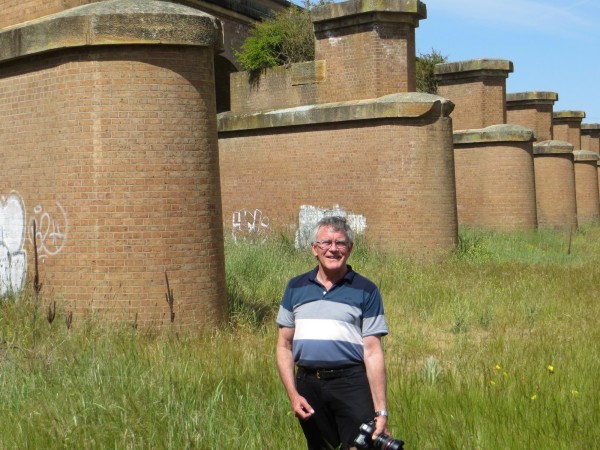
Chair of the ACT Heritage Council David Flannery believes light rail will herald a new era for Canberra, just as the introduction of a train line did for Goulburn, John Thistleton writes.
David Flannery admires the exceptional workmanship in Goulburn’s 1869 brick piers, built for the first railway line into the town.
“These early bricklayers were true artisans proud of their trade,” the Canberra architect and urban planning researcher says.
The piers construction coincided with the start of Goulburn’s golden era of grand public buildings. They reinforce Mr Flannery’s view that light rail will similarly propel Canberra into a new era.
Architect and Chair of the ACT Heritage Council Mr Flannery is a long-term champion of light rail. He is aware of transport’s relationship to planning, most especially the impact cars had on Goulburn and Canberra.
Canberra is full of planning commentators but few have articulated as consistently as Mr Flannery the insidious nature of car-induced urban sprawl, particularly in the territory’s new northern suburbs. Observing Goulburn over recent decades, he said the Hume Highway had once turned the heritage city’s main thoroughfare into a car sewer.
The earlier arrival of rail had a far better impact.
“When rail arrived in 1869, Goulburn was already a prosperous town based on agriculture, I guess, and the arrival of rail guaranteed ongoing prosperity of the town,” Mr Flannery said.
“The city after [the] 1870s and 1880s had a golden age of development. If you look at the court house, the cathedrals, and all the other grand public buildings all happened about that time. I would maintain that would not have been possible had there not been a rail connection.”
Mr Flannery says when Canberra’s first stage of light rail is completed, and the network becomes citywide connecting the town centres and airport, the national capital will flourish.
“Strengthened development will happen in those transit corridors. Hopefully it lessens the amount of land grab that happens because of urban sprawl, that we have more inner city development,” he said.
He says Canberra is one of the least dense cities in Australia.
“The distance from the top end to the bottom of Canberra, from Bonner to Banks, is the same distance as the crow flies, just over 42km, as it is to Bondi Beach from Blacktown. But Sydney has 10 times the population.
“Hopefully that will slow down in the coming decades as more intense development happens in the inner part of the city.”
Graduating from the University of Sydney as an architect, Mr Flannery worked for the NSW Government Architect in Sydney and Newcastle before arriving in Goulburn for 18 months.
He lived in Goulburn from 1981-82, when Australia’s busiest highway had turned the main street into a “car sewer”, before moving to England for postgraduate studies in conservation of the built environment. He took slides to show an audience of international fellow students a history of architecture in Goulburn.
“I have had a fascination of the life and culture and history of Goulburn ever since that time,” Mr Flannery said.
The dominance of cars since the 1950s changed transport and planning in Goulburn and Canberra.
Mr Flannery says the highway bypass in 1992 was built not before time and relieved Goulburn of congestion. A keen photographer, he had trained his telephoto lens from one end of Goulburn’s main street to the other before the highway bypass, capturing the predominance of commercial signs all trying to out-do one another and catch the attention of passing motorists.
“These days with the town returning to a greater awareness of its built heritage, it has tried to tone down the prominence of commercial advertising in the main street,” he said.
“Two and a bit decades after the bypass the city is starting to realise the great benefit of all the beautiful old building stock, a legacy for the city to hang onto for future generations.”
Pictured above is David Flannery, the Chair of the ACT Heritage Council, at the site of Goulburn’s early rail infrastructure. Its construction coincided with a golden era, similar to the potential growth on offer from light rail in Canberra, the architect argues. Photo: John Thistleton.












